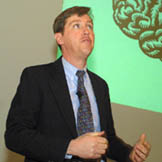BrainPilot
Jeff Hawkins is well known for his innovative designs and sometimes unconventional approach to problems. He designed the PalmPilot and the hand-held communicator Treo, and is chairman and chief product officer of Handspring. Hawkins has some ideas about what intelligence is, and if he is right, it could lead to a technological revolution greater than we can imagine. "I like to make the analogy to the invention of the microprocessor. No one could predict personal computers, no one could predict the cell phone. That's how I feel about the way that building intelligent machines is going to progress. It's going to start with very simple and mundane things but will grow in ways we cannot predict now."
 Neuroscience theorist and PalmPilot inventor Jeff Hawkins
Neuroscience theorist and PalmPilot inventor Jeff Hawkins
Photo: Owen Egan |
|
Hawkins delivered the Montreal Neurological Institute's annual Wilder Penfield lecture on March 13, saying that understanding how our brains work is "the last great terrestrial frontier of science."
His fascination is no passing fancy. Hawkins is cofounder and Director of the Redwood Neuro-science Institute (RNI), which opened in August 2002. This organization is dedicated to developing an integrated theory of how the brain works, specifically the neocortex, which is unique to humans and other mammals and closely associated with intelligence.
The RNI's mission is to develop a good, testable theory for the brain. In order to do this, Hawkins believes researchers from a variety of disciplines — such as biology, math and physics — have to work together and exchange ideas.
Neuroscience has collected a "huge mountain of data," Hawkins said, but there has been almost no overall theory or framework to interpret it. He believes neuroscience lacks the interplay between theories and experiments that is found in other fields of science.
Artificial intelligence, contends Hawkins, is based on the premise that "to build intelligent machines, you don't need to study brains, you just need to program computers." He argued that a machine that shows the right behaviour does not necessarily understand its actions. For example, Deep Blue, the computer that beat world chess champion Gary Kasparov at his own game, captured the world's imagination, but, according to Hawkins, it was no more impressive than a math calculator. It performed well, but didn't show real intelligence, not understanding what it was doing when it played chess.
Hawkins believes that it is the intuitive assumption that intelligence is defined by behaviour that prevents us from having a good brain theory. He said this isn't the first time that our beliefs have gotten in the way of scientific progress. The theory that the Earth is not the centre of the universe was counterintuitive in its day. "There was an intuitive, strongly held but incorrect assumption that prevented us from seeing the answer." Hawkins pointed out that if you believe that Earth is the centre of the universe, and someone says the planet is spinning around at thousands of miles an hour, hurtling through space, you'd think they're crazy. Where's the wind? How come no one's flying off?
Intelligence is about making predictions, Hawkins proposed. He views the neocortex as a memory system that constantly makes predictions about the environment around us, based on sensory input. "Internal prediction is the output of the neocortex, [which] leads to intelligent behaviour."
He used an example he calls "the altered door": If the doorknob on your front door were shifted slightly in any direction, you would notice it was different the instant you reached for it without thinking about it. You would notice other changes, such as if the doorway were narrowed or widened, within seconds. "Brains must be testing these parameters simultaneously during the two or three seconds you open up that door. Your brain is making predictions about what it's going to feel, see and hear."
For commercial applications, Hawkins expects his approach to lead to truly intelligent machines, but starting with the mundane. "I like to think about it as 'what takes intelligence but you can do sitting on your rear end?' Those are good candidates for first applying this technology." He gave the example of a smart car which has to have knowledge of roads and traffic and be able to make predictions about its environment based on sensory input. Hawkins said he has no plans to go into car manufacturing. But he is a strong believer that this research will yield big results.

